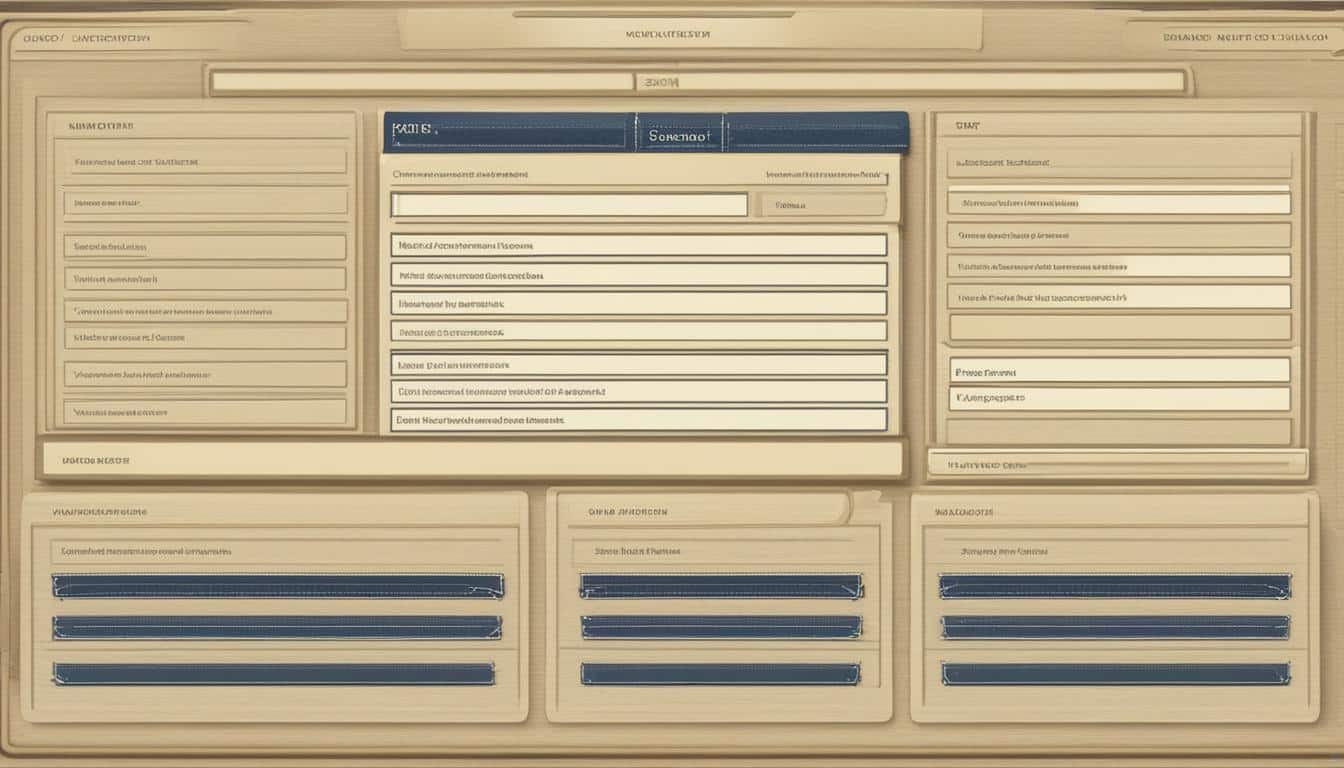
Website forms are a universal element of the web. They are used in various industries and play a vital role in making websites interactive. The design of web forms is crucial for creating a positive user experience and achieving business goals. Web forms allow users to perform actions such as creating accounts, making purchases, and collecting data. The design principles for web forms include simplicity, consistency, alignment, visual hierarchy, context, validation and error prevention, progressive illumination, accessibility, and privacy and security.
Key Takeaways:
- Designing web forms is essential for creating a positive user experience and achieving business goals.
- Web form design principles include simplicity, consistency, alignment, visual hierarchy, context, validation and error prevention, progressive illumination, accessibility, and privacy and security.
- Optimizing HTML form attributes can enhance the functionality and user-friendliness of web forms.
- Form optimization plays a crucial role in improving form experience and increasing conversions.
- Continuously testing and optimizing forms can lead to compelling and productive forms that align with business goals.
Understanding Web Form Design Principles
When it comes to web form design, there are several key principles that can greatly enhance the user experience and overall usability. By following these principles, web developers can optimize their forms for better functionality and increased conversion rates. Let's take a closer look at some essential web form design tips and guidelines.
Simplicity
The first principle of effective web form design is simplicity. Keep your forms clean and clutter-free, with a clear layout that guides users through the process. Avoid unnecessary fields and only ask for information that is truly essential. By simplifying your forms, you can reduce friction and improve completion rates.
Consistency
Consistency is another crucial aspect of web form design. Use a consistent design language across your website to create a cohesive user experience. This includes using the same colors, fonts, and styling for your form elements, as well as maintaining a consistent flow and structure throughout the form.
Alignment and Spacing
Proper alignment and spacing are important for creating visually appealing and easy-to-use forms. Align your labels and input fields to ensure a clear visual hierarchy and make it easy for users to understand the relationship between different form elements. Leave enough space between fields to avoid crowding and make it easier for users to interact with the form.
Visual Hierarchy
Creating a clear visual hierarchy is essential for guiding users through your form and highlighting important information. Use visual cues such as font size, color, and formatting to draw attention to important fields or instructions. This helps users understand the flow of the form and ensures they don't miss any important details.
Validation and Error Prevention
Validation and error prevention are critical for a seamless form filling experience. Implement real-time validation to provide immediate feedback to users and prevent them from submitting incorrect data. Use clear error messages and visual indicators to help users understand and correct any mistakes. By proactively addressing errors, you can minimize frustration and increase form completion rates.
By understanding and implementing these web form design principles, you can create forms that are user-friendly, visually appealing, and optimized for better functionality. Remember to constantly test and refine your forms to ensure they align with the goals of your website and provide a seamless user experience.
Optimizing HTML Form Attributes for Better Functionality
When it comes to creating user-friendly and functional web forms, optimizing HTML form attributes is crucial. These attributes allow web developers to enhance the functionality of forms and provide a better user experience. By utilizing the right attributes, businesses can boost their web form conversion rates and improve overall user satisfaction.
One essential attribute to optimize is the "action" attribute, which specifies the URL where the form data will be submitted. By specifying the correct URL, businesses can ensure that form submissions are processed correctly and efficiently. Additionally, the "method" attribute defines the HTTP method to be used when submitting the form data. By utilizing the appropriate method, such as POST or GET, businesses can enhance the security and efficiency of form submissions.
Another important attribute is "required." By adding the "required" attribute to form fields, businesses can enforce the completion of essential fields and prevent users from submitting incomplete forms. The "pattern" attribute is also beneficial, as it allows businesses to set specific patterns for user input, such as phone numbers or email addresses, ensuring the validity of the data collected. The "min" and "max" attributes can be used to define the minimum and maximum values allowed for numerical inputs, providing additional validation to prevent errors.

Table: Examples of HTML Form Attributes and Their Functionality
| Attribute | Functionality |
|---|---|
| action | Specifies the URL where form data will be submitted |
| method | Defines the HTTP method to be used when submitting form data |
| required | Enforces completion of essential form fields |
| pattern | Sets specific input patterns for validation (e.g., email addresses, phone numbers) |
| min and max | Defines the minimum and maximum values allowed for numerical inputs |
By leveraging these HTML form attributes and optimizing their usage, businesses can create web forms that are more functional, user-friendly, and effective at driving conversions. Web developers should carefully consider the attributes that align with their specific form requirements and implement them accordingly. Through continuous testing and optimization of form attributes, businesses can achieve better functionality and ultimately improve their web form conversion rates.
The Importance of Form Optimization for Digital Success
As a web developer, I understand the crucial role that optimized web forms play in achieving digital success. User-friendly web forms are essential for businesses to finalize purchases, gain access to online communities, and collect valuable information. By optimizing the design of these forms, companies can significantly improve the form experience and increase conversions.
One of the key factors in form optimization is the use of logic, labels, hints, input masks, and prefilling. By implementing logical and intuitive form flows, users can easily navigate through the fields and provide accurate information. Clear and concise labels and hints guide users, reducing the chance of errors and minimizing frustration. The use of input masks ensures that users input data in the correct format, enhancing the overall user experience. Prefilling certain fields with known information can save users time and further streamline the form completion process.
Continuous testing and optimization are crucial for creating compelling and productive web forms. By analyzing user behavior, businesses can identify pain points, areas of confusion, and potential barriers to conversion. Optimizing forms based on these insights can lead to higher completion rates and improved user satisfaction.
In conclusion, optimizing web forms is a fundamental aspect of digital success. User-friendly forms that align with business goals and provide an excellent user experience are essential for increasing conversions and achieving the desired outcomes. By implementing best practices, testing, and continuous optimization, businesses can create web forms that drive results and contribute to overall digital success.
FAQ
What are the best practices for web forms?
The best practices for web forms include simplicity, consistency, alignment, visual hierarchy, context, validation and error prevention, progressive illumination, accessibility, and privacy and security.
Why are web form design principles important?
Web form design principles are essential for creating practical, user-friendly, and aesthetically pleasing form designs. By following these principles, web developers can enhance the completion rate of forms, minimize errors, and improve the overall user experience.
How can HTML form attributes enhance web forms?
HTML form attributes such as action, method, required, pattern, min, max, and placeholder can be used to specify the form's submission URL, submission method, add validation, and provide hints to users. By utilizing these attributes effectively, web developers can create forms that are more functional and user-friendly, leading to better conversion rates and improved user satisfaction.
Why is form optimization important for digital success?
The success of a digital enterprise is directly proportional to the quality of the forms used on a website. Optimizing form design is crucial for improving the form experience and increasing conversions. By continuously testing and optimizing forms, businesses can create forms that are compelling, productive, and align with the goals of the enterprise.











